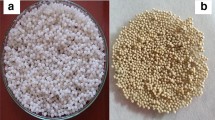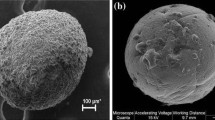Abstract
In this study, spherical beads have been prepared by ionotropic gelation of sodium alginate using two types of cross-linking, physical cross-linking in the presence of Ca2+ ions and chemical cross-linking which was made with epichlorohydrin for environmental applications. The different beads of alginate were characterized by Fourier transform infrared spectroscopy, optical microscopy, scanning electron microscopy, and X-ray diffractometry to provide evidence of successful cross-linking. The physicochemical properties of the beads such as the average diameter, water content, the zero charge point, and the density were also determined. The efficiency of the beads as biosorbent for the removal of dyes is assessed using methyl violet (MV) as a model molecule. A comparative adsorption performance of wet calcium alginate beads (WCaAB), dry calcium alginate beads (DCaAB), wet epichlorohydrin cross-linked alginate beads (WEpAB), and dry epichlorohydrin cross-linked alginate beads (DEpAB) was made. The adsorption of methyl violet MV on cross-linked alginate beads was found to be comparatively higher than that of WCaAB, DCaAB, and WEpAB. The extent of adsorption of methyl violet MV onto cross-linked alginate beads (DEpAB) was found to be a function of the pH of the solution, contact time, sorbate concentration, amount of beads and stirring speed. The kinetics adsorption of MV onto cross-linked alginate beads (DEpAB) was investigated using the pseudo-first-order, pseudo-second-order, and intraparticle diffusion kinetic models. The results showed that the pseudo-second-order kinetic model adequately describes the experimental data.



Reproduced with permission from [39]









Similar content being viewed by others
References
Ya-Fen L, Hua-Wei C, Poh-Sun C, Chyow-San C, Cheng-Chung L (2011) Application of bifunctional magnetic adsorbent to adsorb metal cations and anionic dyes in aqueous solution. J Hazard Mater 185:1124–1130
Ting L, Tao X, Xue-Lian H, Cheng L, Wei-Feng Z, Qian Z, Chang-Sheng Z (2015) Post-crosslinking towards stimuli-responsive sodium alginate beads for the removal of dye and heavy metals. Carbohydr. Polym. 133:587–595
Crini G (2006) Non-conventional low-cost adsorbents for dye removal: a review. Biores Technol. 97:1061–1085
Pearce CI, Lloyd JR, Guthrie JT (2003) The removal of colour from textile wastewater using whole bacterial cells: a review. Dyes Pigments 58:179–196
Tan IAW, Hameed BH, Ahmad AL (2007) Equilibrium and kinetic studies on basic dye adsorption by oil palm fibre activated carbon. Chem. Eng. J. 127:111–119
Raffainer II, Rudolf von Rohr P (2001) Promoted wet oxidation of the azo dye Orange II under mild conditions. Ind. Eng. Chem. Res. 40:1083–1089
Elwakeel KZ, El-Bindary AA, El-Sonbati AZ, Hawas AR (2017) Magnetic alginate beads with high basic dye removal potential and excellent regeneration ability. Rev. Can. Chim. 95(8):807–815
Shojaat R, Saadatjoo N, Karimi A, Aber S (2016) Simultaneous adsorption–degradation of organic dyes using MnFe2O4/calcium alginate nano-composites coupled with GOx and laccase. J. Environ. Chem. Eng. 4:1722
Ali I, Gupta VK (2007) Advances in water treatment by adsorption technology. Nat. Protoc. 1:2661
Subbaiah MV, Kim DS (2016) Adsorption of methyl orange from aqueous solution by aminated pumpkin seed powder: kinetics, isotherms, and thermodynamic studies. Ecotoxicol. Environ. Saf. 128:109
Lakshmipathy R, Sarada NC (2016) Methylene blue adsorption onto native watermelon rind: batch and fixed bed column studies. Desalin. Water. Treat. 57:10632
Al-Kahtani AA, Abou Taleb MF (2016) Photocatalytic degradation of Maxilon CI basic dye using CS/CoFe2O4/GONCs as a heterogeneous photo-Fenton catalyst prepared by gamma irradiation. J. Hazard. Mater. 309:10–19
Vaiano V, Iervolino G, Sannino D, Murcia JJ, Hidalgo MC, Ciambelli P, Navío JA (2016) Photocatalytic removal of patent blue V dye on Au–TiO2 and Pt–TiO2 catalysts. Appl. Catal. B 188:134–146
Thangavel S, Thangavel S, Raghavan N, Krishnamoorthy K, Venugopal G (2016) Visible-light driven photocatalytic degradation of methylene-violet by rGO/Fe3O4/ZnO ternary nanohybrid structures. J. Alloys Compd. 665:107
Aravind P, Subramanyan V, Ferro S, Gopalakrishnan R (2016) Eco-friendly, and facile integrated biological-cum-photo assisted electrooxidation process for degradation of textile wastewater. Water Res. 93:230
Benjwal P, Kar KK (2015) Removal of methylene blue from waste water under low power irradiation source by Zn, Mn co-doped TiO2 photocatalyst. RSC Adv. 5:98166
Papic S, Koprivanac N, Bozic AL, Metes A (2004) Removal of some reactive dyes from synthetic wastewater by combined Al(III) coagulation/carbon adsorption process. Dyes Pigments 62:291
Bouras HD, Benturki O, Bouras N, Attou M, Donnot A, Merlin A, Addoun F, Holtz MD (2015) The use of an agricultural waste material from Ziziphus jujuba as a novel adsorbent for humic acid removal from aqueous solutions. J. Mol. Liq. 211:1039–1046
Baban A, Yediler A, Lienert D, Kemerdere N, Kettrup A (2003) Ozonation of high strength segregated effluents from a woollen textile dyeing and finishing plant. Dyes Pigments 58:93
Xu L, Sun Y, Zhang L, Zhang J, Wang F (2015) Electrochemical oxidation of C.I. Acid Red 73 wastewater using Ti/SnO2–Sb electrodes modified by carbon nanotube. Desalin. Water. Treat. 57:8815–8825
Edip B, Erol A (2010) Electrochemically enhanced removal of polycyclic aromatic basic dyes from dilute aqueous solutions by activated carbon cloth electrodes. Environ. Sci. Technol. 44:6331–6336
Ledakowicz S, Solecka M, Zylla R (2001) Biodegradation, decolourisation and detoxification of textile wastewater enhanced by advanced oxidation processes. J. Biotechnol. 89:175
Tan BH, Teng TT, Mohd Omar AKM (2000) Removal of dyes and industrial dye wastes by magnesium chloride. Water Res. 34:597–601
Koyuncu I, Topacik D, Yuksel E (2004) Reuse of reactive dye house wastewater by nanofiltration: process water quality and economical implications. Sep. Purif. Technol. 36:77–85
Slejko FL (1985) Adsorption Technology: A Step-by-step Approach to Process Evaluation and Application. Marcel Dekker, New York
Hasan S, Krishnaiah A, Ghosh TK, Viswanath DS (2006) Adsorption of divalent cadmium (Cd(II)) from aqueous solutions onto chitosan-coated perlite beads. Ind. Eng. Chem. Res. 45:5066–5077
Huang GL, Zhang HY, Shi JX, Langrish TAG (2009) Adsorption of chromium(VI) from aqueous solutions using cross-linked magnetic chitosan beads. Ind. Eng. Chem. Res. 48:2646–2651
Kumar NS, Suguna M, Subbaiah MV, Reddy AS, Kumar NP, Krishnaiah A (2010) Adsorption of phenolic compounds from aqueous solutions onto chitosan-coated perlite beads as biosorbent. Ind. Eng. Chem. Res. 49:9238–9247
Rocher V, Siaugue J-M, Cabuil V, Bee A (2008) Removal of organic dyes by magnetic alginate beads. Water Res. 42:1290–1298
Fundueanu G, Nastruzzi C, Carpov A, Desbrieres J, Rinaudo M (1999) Physico-chemical characterization of Ca-alginate microparticles produced with different methods. Biomaterials 20:1427–1435
Blandino A, Macias M, Cantero D (1999) Formation of calcium alginate gel capsules: influence of sodium alginate and CaCl2 concentration on gelation kinetics. J. Biosci. Bioeng. 88(6):686–689
Rocher V, Bee A, Siaugue J-M, Cabuil VE (2010) Dye removal from aqueous solution by magnetic alginate beads crosslinked with epichlorohydrin. J. Hazard. Mater. 178:434–439
Zhao W, Wahyu R, Nugroho N, Odelius K, Edlund U, Zhao C, Albertsson AC (2015) In situ cross-linking of stimuli-responsive hemicellulose microgels during spray drying. CS Appl. Mater. Interfaces 7(7):4202–4215. https://doi.org/10.1021/am5084732
Zhao W, Odelius K, Edlund U, Zhao C, Albertsson AC (2015) In situ synthesis of magnetic field-responsive hemicellulose hydrogels for drug delivery. Biomacromolecules 16(8):2522–2528. https://doi.org/10.1021/acs.biomac.5b00801
Vijayakumar G, Dharmendirakumar M, Renganathan S, Sivanesan S, Baskar G, Elango KP (2009) Removal of congo red from aqueous solutions by perlite. Clean-Soil Air Water 37:355–364
Ho Y, McKay G (1999) Pseudo-second order model for sorption processes. Process Biochem. 34:451–465
Weber WJ, Morris JC (1963) Kinetics of adsorption on carbon from solution. Eng. Div. Proc. Am. Soc. Civil Eng. 89:31–60
Smidsrod O (1974) Molecular basis for some physical properties of alginate in gel state. Faraday Discuss. Chem. Soc. 57:263
Bhattarai N, Zhang MQ (2007) Controlled synthesis and structural stability of alginate-based nanofibers. Nanotechnology. https://doi.org/10.1088/0957-4484/18/45/455601
Gupta VK, Jain R, Varshney S, Saini VK (2007) Removal of Reactofix Navy Blue 2 GFN from aqueous solution using adsorption techniques. Colloid. Interface Sci. 307:326–332
Meenakshi Sundaram M, Sivakumar S (2012) Use of Indian almond shell waste and groundnut shell waste for the removal of azure A dye from aqueous solution. J. Chem. Pharm. Res. 4:2047–2054
Crini G, Peindy HN, Gimbert F, Robert C (2007) Removal of CIBasic Green 4 (Malachite Green) from aqueous solutions by adsorption using cyclodextrin-based adsorbent: kinetic and equilibrium studies. Sep. Purif. Technol. 53:97–110
Elbariji S, Elamine M, Eljazouli H, Kabli H, Lacherai A, Albourine A (2006) Traitement et valorisation des sous-produits du bois. Application à l’élimination des colorants industriels. C.R. Chimie 9:1314–1321
Author information
Authors and Affiliations
Corresponding author
Rights and permissions
About this article
Cite this article
Merakchi, A., Bettayeb, S., Drouiche, N. et al. Cross-linking and modification of sodium alginate biopolymer for dye removal in aqueous solution. Polym. Bull. 76, 3535–3554 (2019). https://doi.org/10.1007/s00289-018-2557-x
Received:
Revised:
Accepted:
Published:
Issue Date:
DOI: https://doi.org/10.1007/s00289-018-2557-x




